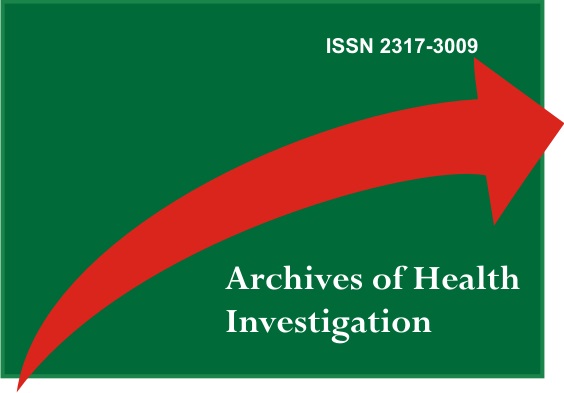Prevalencia y factores asociados de disfunción sexual en mujeres después de una mastectomía: estudio transversal
DOI:
https://doi.org/10.21270/archi.v10i5.5278Palabras clave:
Cáncer de Mama, La salud de la Mujer, Promoción de la SaludResumen
El cáncer de mama es uno de los tumores más comunes entre las mujeres y causa trastornos cardiovasculares, motores y sexuales. El objetivo del estudio fue identificar la prevalencia de disfunción sexual en mujeres mastectomizadas y analizar la correlación entre los dominios de la respuesta sexual en las fases de la respuesta sexual femenina. Se trata de un estudio transversal con 54 mujeres que se sometieron a cirugía de mastectomía de 30 a 59 años. Para evaluar la disfunción sexual se utilizó el instrumento Índice de Función Sexual Femenina. Se pudo comprobar que la prevalencia de disfunción sexual entre mujeres mastectomizadas fue del 77,7%. Las fases de la respuesta sexual que se vieron significativamente afectadas fueron: excitación (r = 0,86), lubricación (r = 0,80), orgasmo (r = 0,86), satisfacción (r = 0,81), dolor (r = 0,80) y la primera fase de la respuesta sexual, que es el deseo (r = 0,41), presentó una correlación moderada. En cuanto al desempeño sexual, ninguna mujer tuvo un desempeño excelente, solo 12 tuvieron un buen resultado y 42 tuvieron un mal resultado. Hubo una alta prevalencia de disfunción sexual entre las mujeres mastectomizadas, con cambios en aspectos relacionados con la excitación, lubricación, orgasmo, satisfacción y dolor. Sugerimos, por tanto, que se realicen más estudios que aborden este tema, para dilucidar la relación entre los dominios de la respuesta sexual y la disfunción sexual en mujeres sometidas a mastectomía. Es evidente la importancia de promover estrategias, acciones e intervenciones de promoción de la salud para mujeres mastectomizadas en el contexto de la interdisciplinariedad.
Descargas
Citas
Bastianello MR, Hutz CS. Otimismo e suporte social em mulheres com câncer de mama: uma revisão sistemática. Psicol Teor Prat. 2016;18(2):19-33.
Ministério da Saúde; Instituto Nacional de Câncer- INCA.Biblioteca On-Line. Acesso em: 11 dez. 2010. Disponível em: https://www.inca.gov.br/controle-do-cancer-de-mama/conceito-e-magnitude
Fagundes, MKV Vaccaro MM. Mastectomia radical e sua influência sobre a vivência da sexualidade feminina. Uningá Review. 2016; 25(1):79-86.
Cesnik VM, Santos MA. Mastectomia e sexualidade: uma revisão integrativa. Psicologia: Reflex Crit. 2012;25(2):339-49.
Almeida TRD, Guerra MR, Filgueiras MST. Repercussões do câncer de mama na imagem corporal da mulher: uma revisão sistemática. Physis. 2012;22(3):1003-29.
Auwad WA, Hagi SK. Female sexual dysfunction: what Arab gynecologists think and know. Int Urogynecol J. 2012;23(1):919-27.
Santos DBS, Santos MA, Vieira EM. Sexualidade e câncer de mama: Uma revisão sistemática da literatura. Saúde Soc. 2014;23(4):1342-55.
Raposo JV, Moreira TL, Arbinaga F, Teixeira CM. Satisfação sexual em pacientes com câncer. Acta Colomb Psicol. 2017;20(2):84-94.
Macedo JB, Brondani AS, Costa GS, Messias BES, Nardi LLD, Braz MM. Occurrence of sexual dysfunctions in mastectomized females with or without breast reconstruction. Acta Scientiarum. 2018;40(1):e34544.
Antunes MD, Nishida FS. Morbidade hospitalar em idosos do paraná durante o ano de 2016. Encicl Biosf. 2017;14(26):1166-74.
Pacagnella RDC, Vieira EM, Rodrigues JOM, Souza CD. Adaptação transcultural do female sexual function index. Cad Saúde Pública. 2008;24(2):416-26.
Canário ACG, Paiva LC, Florêncio GLD, Melo CMLN, Gonçalves AK. Prevalência de disfunção sexual em mulheres sobreviventes de câncer de mama. Anais CIEH. 2015;2(1):1-7.
Sreelakshmy K, Velayudhan R, Kuriakose D, Nair R. Sexual dysfunction in females with depression: a cross- sectional study. Trends Psychiatry Psychother. 2017;39(2):106-9.
Pegorare ABGS, Silveira KR, No Ana PS, Barbosa SRM. Assessment of female sexual function and quality of life among breast cancer survivors who underwent hormone therapy. Mastology. 2017;27(3):237-44.
Siegel R, DeSantis C, Virgo K, Stein K, Mariotto A, Smith T et al. Cancer treatment and survivorship statistics, 2012. CA Cancer J Clin. 2012;62(4):220-41.
Souza ACS. Antidepressivos e disfunções sexuais. Rev Psychiatrv. 2017;17(8):1-10.
Siegel R, DeSantis C, Virgo K, Stein K, Mariotto A, Smith T et al. Cancer treatment and survivorship statistics, 2012. CA Cancer J Clin. 2012;62(4):220-41.
Araújo, A. C. G. C.; Nascimento, C. M. L.; Neto, P. F. A.; Silva,B. R. C.; Araújo, K. Q. M. A.; Gonçalves, A. K. Prevalência de disfunção sexual em mulheres sobreviventes de câncer de mama. Top Cienc Saude. 2019;11(1):107-16.
Berghmans B. Physiotherapy for pelvic pain and female sexual dysfunction: an untapped resource. Inter Urogynecol J. 2018;29(1):631-38.


